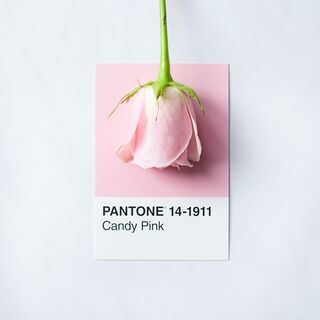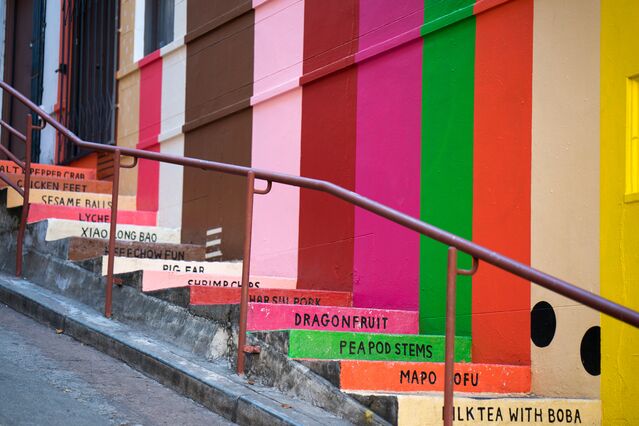Consumer Behavior
What Do You Associate With “Royal Berry” or “Vanilla Scoop”?
Word associations inform us about how we organise knowledge.
Posted January 28, 2021 Reviewed by Matt Huston

You would like to change something in your life and decide to change the colours of the walls in your living room. Perhaps you consider doing the same for your kitchen and bedroom. So, you go to the DIY shop to get inspired and select the perfect shade. You find the right shelf, silently gasp and think, “So much to choose from! Where shall I start?”
You grab a colour fan, a nice visual display of all the colours the shop can mix for you on demand. Now, you find yourself staring at an even larger range of possibilities. You might feel lost and confused. You inspect the colour fan more closely: “Really, somebody has given names to all these colours?” They sound lovely and imaginative: Cranberry Crunch, Love Note, Fragrant Cloud, Vanilla Scoop, Lime Zest, and Royal Berry, among many more. Perhaps, if you select the respective paint, you will also be reminded of these names when looking at your newly painted walls. Maybe, you will even feel love, smell vanilla, and think of an amazing royal feast. Or else these words will remain just words, and have no impact on your actual affective and psychological states.
Semantic associations
Many researchers, including us, are interested in how quickly one thought can lead to another, and sometimes even change our feelings along the way. Just ask someone what first comes to mind when hearing or reading the word MOTHER. They are highly likely to answer FATHER or CHILD. You can play this “game” with any word or try it out in our ongoing survey. Obvious associations are CAT and MOUSE, BREAD and BUTTER, SISTER and BROTHER, and so on. These associations reflect factual knowledge, remaining constant across time and people, illustrating how we organise knowledge. Other associations might be more relational and episodic. Imagine that we show you the word FRIEND. If you have good relationships with your friends, you might answer FUN or TRUST. If, however, you’ve just found out that a supposedly close friend is gossiping behind your back, you might answer DISAPPOINTMENT or BETRAYAL.

Now, accepting that our brains are highly associative, activating all sorts of memories, we can return to the original question. Do words and labels for products like wall paint have any psychological effect? Also, would knowledge about a product, such as its colours, maybe also its odour, flavour, or texture, impact our everyday behaviour? To answer such questions, we need to know whether a lot of people generate similar associations with “things” and “ideas,” and determine so-called Semantic Networks or Associative Networks. These networks show how people organize their knowledge on an abstract level, because words are by default abstract concepts. Some words, like MOTHER, DAUGHTER, and FAMILY, are strongly connected with each other but less strongly connected with other concepts, such as SCHOOL. However, if the concept SCHOOL is triggered, for instance by thinking about one’s children, it immediately activates other closely related concepts, like TEACHER, PEN, and LEARNING. Of course, some concepts are only weakly or not at all connected, such as CAULIFLOWER and SHAME. Yet, for some few individuals, these concepts could be associated. For example, imagine you stole the only cauliflower your neighbour managed to grow in their garden. The next day, you see them very upset, and you feel ashamed.
What about language and culture?

Back to colour names, their associations, and their potential to impact us. Let us think about marketing. Imagine, a paint company, which wishes to boost the attractiveness (and sales) of their colours. Their headquarters is based in Switzerland, where we happen to live. The company hires a marketing firm to learn what people associate with different colours. Having asked random people in their vicinity, the marketing firm concludes that people frequently associate SNOW, MOUNTAINS, and PURITY with WHITE. Based on this information, the paint company decides to name various shades of their white paints Frosty Lake, Snow White, and Innocent Winter. Obviously, you can introduce the first two names to the Chinese market too, but the last one is less obvious. We know that Chinese people associate WHITE with DEATH and SADNESS, as it’s a common funeral colour. Consequently, most Chinese would relate WHITE less so to the meaning of youthfulness and innocence.
Overall, we would expect few differences across languages and cultures for factual associations like MOTHER-CHILD. For other associations, however, we would expect differences. Let’s take the word LOVE. Do you think LOVE (English), AMOUR (French), LIEBE (German), and MEILĖ (Lithuanian) represent the same “thing”? A recent study shows that emotion terms have some universal but also some language-specific connotations. Even among English speakers, LOVE can evoke many different associations, both positive and negative. Some might think of PASSION and DESIRE, while others might think of DEVOTION and ROMANCE, and still others think of related concepts such as AFFECTION or TENDERNESS. Some might think about different types of love, perhaps the love of a parent towards their child, or a person’s love of God.
As a cautionary note, working regularly on such data sets, we have learned that one shouldn’t expect others to share our associations, thoughts, or emotions when seeing the same words. As a consequence, we are likely to observe different emotional reactions or behaviours due to different associations. You might be eager to paint your walls in Vanilla Scoop, but somebody sharing your living space might find it too sweet and would prefer a more refreshing colour, like Lemon Spirit.
Ongoing research
If you have a spare moment to dive deeper into your personal associations, feel free to contribute to our ongoing association study. In this study, we are collecting association data in seven different languages: Italian, Spanish, French, German, Lithuanian, Estonian, and of course English. By clicking on this link, you can access all those languages. With the help of our colleagues, Prof. Mari Uusküla from Tallinn University and Déborah Da Silva from the University of Lausanne, we are hoping to compare the English speakers with the rest. We want to understand the role of language and culture in free associations, and by inference, their impact on the construction of knowledge, including knowledge about colours.
References
De Deyne, S., & Storms, G. (2008). Word associations: Network and semantic properties. Behavior Research Methods, 40(1), 213–231. https://doi.org/10.3758/BRM.40.1.213
Jackson, J. C., Watts, J., Henry, T. R., List, J. M., Forkel, R., Mucha, P. J., Greenhill, S. J., Gray, R. D., & Lindquist, K. A. (2019). Emotion semantics show both cultural variation and universal structure. Science, 366(6472), 1517–1522. https://doi.org/10.1126/science.aaw8160
Jonauskaite, D., Wicker, J., Mohr, C., Dael, N., Havelka, J., Papadatou-Pastou, M., Zhang, M., & Oberfeld, D. (2019). A machine learning approach to quantify the specificity of colour–emotion associations and their cultural differences. Royal Society Open Science, 6(9), 190741. https://doi.org/10.1098/rsos.190741


